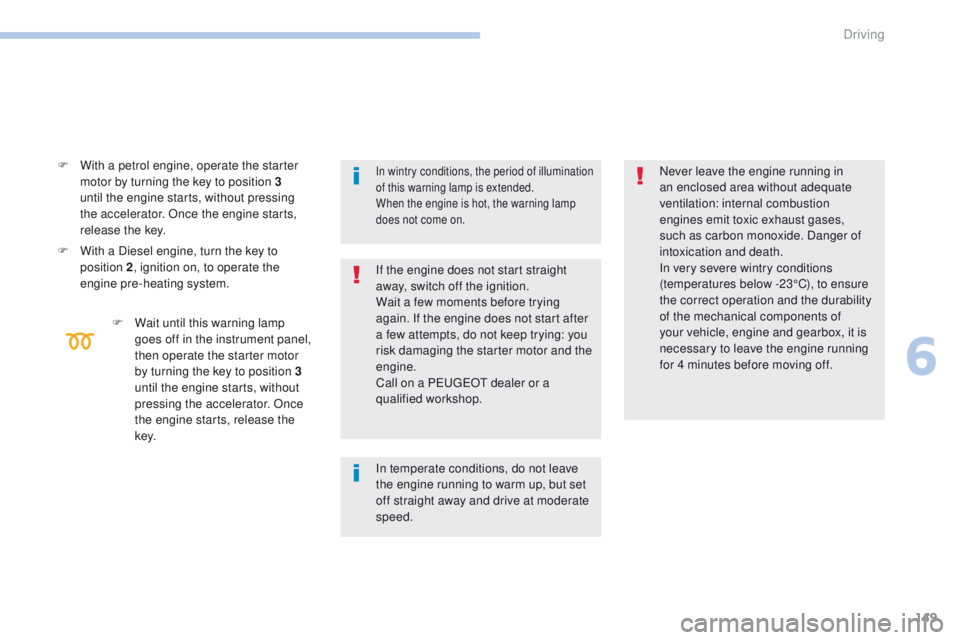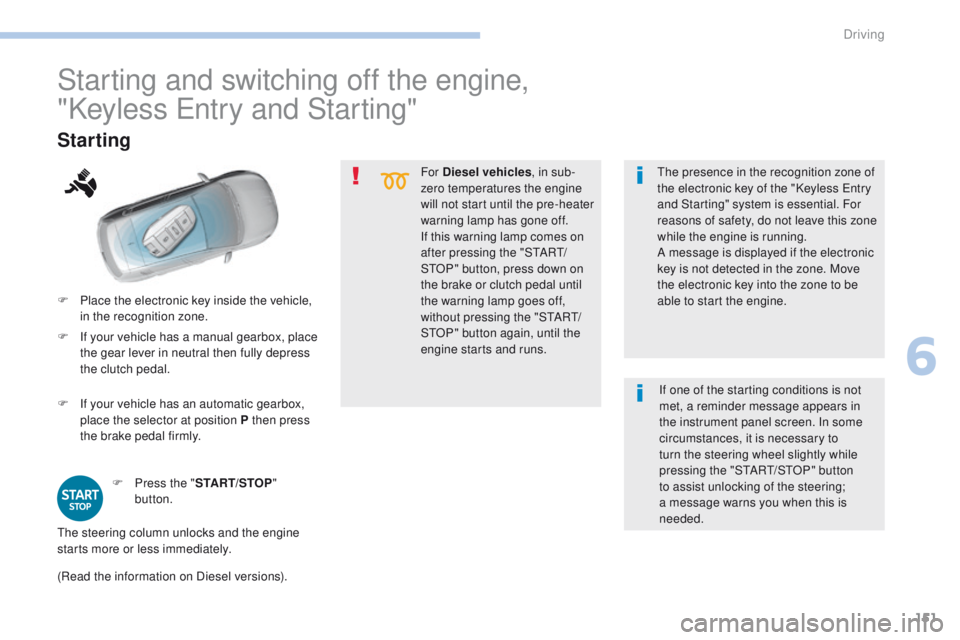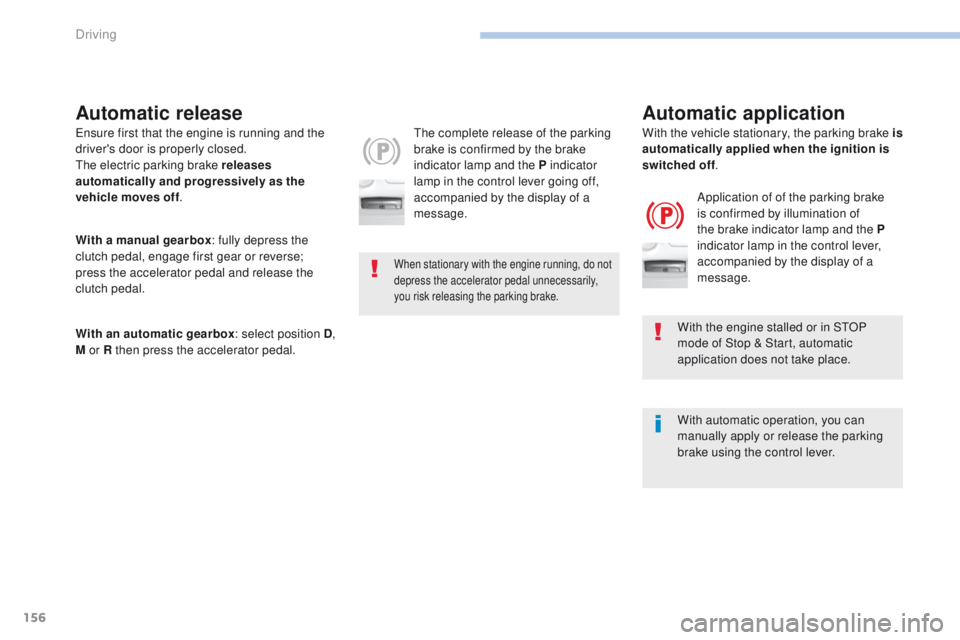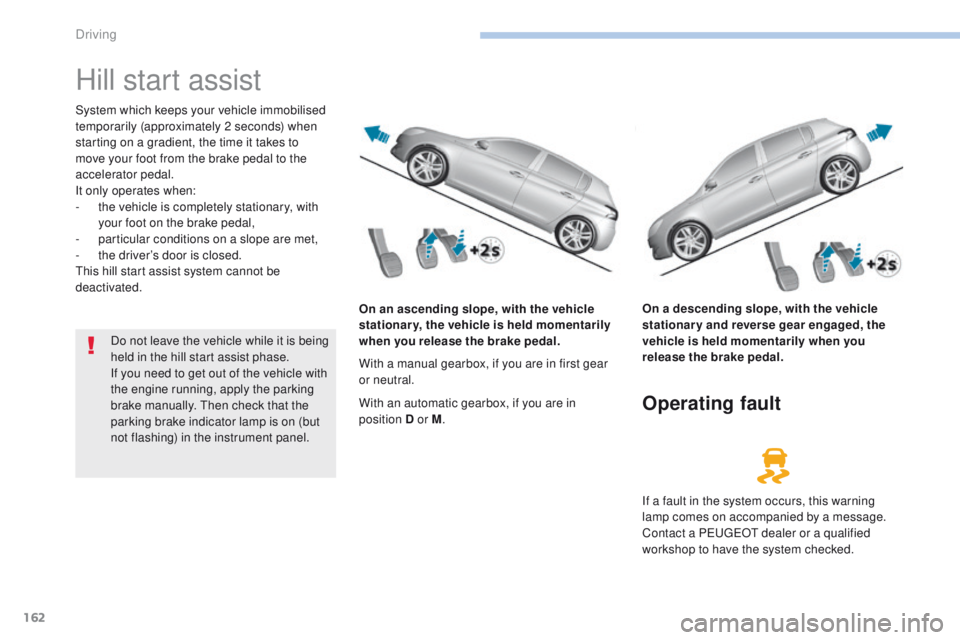Page 150 of 392
148
Starting-switching off the engine, remote control
Put the gear lever into neutral.
Ignition switch
1. Stop position.
2. I gnition on position.
3.
S
tarting position.
Starting using the key
the parking brake must be applied.
F
I
nsert the key in the ignition switch.
t
h
e system recognises the starting code.
F
u
n
lock the steering column by
simultaneously turning the steering wheel
and the key.
F
W
ith a manual gearbox, place the gear
lever in neutral then fully depress the clutch
pedal.
In certain circumstances, you may have
to apply some force to turn the wheels
(if the wheels are against a kerb, for
example).
F
W
ith an automatic gearbox, place the gear
lever at position N or P then press the
brake pedal firmly.
Driving
Page 151 of 392

149
F With a petrol engine, operate the starter motor by turning the key to position 3
until the engine starts, without pressing
the accelerator. Once the engine starts,
release the key.
F
W
ith a Diesel engine, turn the key to
position 2 , ignition on, to operate the
engine pre-heating system.
F
W
ait until this warning lamp
goes off in the instrument panel,
then operate the starter motor
by turning the key to position 3
until the engine starts, without
pressing the accelerator. Once
the engine starts, release the
key.In wintry conditions, the period of illumination
of this warning lamp is extended.
When the engine is hot, the warning lamp
does not come on.
In temperate conditions, do not leave
the engine running to warm up, but set
off straight away and drive at moderate
speed. If the engine does not start straight
away, switch off the ignition.
Wait a few moments before trying
again. If the engine does not start after
a few attempts, do not keep trying: you
risk damaging the starter motor and the
engine.
Call on a P
e
uge
Ot
dealer or a
qualified workshop. Never leave the engine running in
an enclosed area without adequate
ventilation: internal combustion
engines emit toxic exhaust gases,
such as carbon monoxide. Danger of
intoxication and death.
In very severe wintry conditions
(temperatures below -23°C), to ensure
the correct operation and the durability
of the mechanical components of
your vehicle, engine and gearbox, it is
necessary to leave the engine running
for 4 minutes before moving off.
6
Driving
Page 153 of 392

151
For Diesel vehicles, in sub-
zero temperatures the engine
will not start until the pre-heater
warning lamp has gone off.
If this warning lamp comes on
after pressing the "S
tA
R
t/
StO
P" button, press down on
the brake or clutch pedal until
the warning lamp goes off,
without pressing the "S
tA
R
t/
StO
P" button again, until the
engine starts and runs.
F
P
lace the electronic key inside the vehicle,
in the recognition zone.
Starting
F Press the " START/STOP"
button.
th
e presence in the recognition zone of
the electronic key of the "Keyless e
n
try
and Starting" system is essential. For
reasons of safety, do not leave this zone
while the engine is running.
A message is displayed if the electronic
key is not detected in the zone. Move
the electronic key into the zone to be
able to start the engine.
Starting and switching off the engine,
"Keyless e
n
try and Starting"
the steering column unlocks and the engine
starts more or less immediately. If one of the starting conditions is not
met, a reminder message appears in
the instrument panel screen. In some
circumstances, it is necessary to
turn the steering wheel slightly while
pressing the "S
tA
R
t/
S
tO
P" button
to assist unlocking of the steering;
a message warns you when this is
needed.
(Read the information on Diesel versions). F
I
f your vehicle has a manual gearbox, place
the gear lever in neutral then fully depress
the clutch pedal.
F
I
f your vehicle has an automatic gearbox,
place the selector at position P then press
the brake pedal firmly.
6
Driving
Page 155 of 392

153
When the electronic key is not detected or is
no longer in the recognition zone, a message
appears in the instrument panel when you
close a door or when you request switching off
the engine.
F
P
ress the "S
tA
R
t/
S
tO
P" button.
th
e engine starts.
Emergency switch-off
F If your vehicle has a manual gearbox, place
the gear lever in neutral then fully depress
the clutch pedal.
F
I
f your vehicle has an automatic gearbox,
place the selector at position P then press
the brake pedal firmly.
In the event of a fault with the electronic key,
contact a P
e
uge
Ot
dealer or a qualified
workshop. F
t
o c
onfirm the request to switch off the
engine, press and hold the "S
tA
R
t/
S
tO
P"
button for about five seconds.
Back-up switch off
Key left in reader
You are warned by a message if the
electronic key is is still in the reader on
opening the driver's door.
In the event of an emergency only, the engine
can be switched off without conditions (even
when driving).
Press and hold the "S
tA
R
t/
S
tO
P" button for
about five seconds.
In this case the steering column locks as soon
as the vehicle stops.
6
Driving
Page 157 of 392

155
electric parking brake
Never leave a child alone inside the
vehicle with the ignition on, as they
could release the parking brake.Indicator lamp
this indicator lamp comes on in the
instrument panel and in the control
lever to confirm the application of the
parking brake.
th
e system allows the application of the
parking brake on switching off the engine and
release as the vehicle moves off.
When towing, parking on a steep slope,
or if your vehicle is heavily laden,
turn the wheels towards the kerb and
engage a gear.
For towing, your vehicle is approved for
parking on slopes of up to 12%.
It goes off to confirm the release of the parking
brake.
th
e indicator lamp in the control lever
flashes during manual application or
release. In the event of a battery failure, the
electric parking brake no longer works.
As a safety measure, if the parking
brake is not applied, immobilise the
vehicle by placing a chock against one
of the wheels.
th
e driver can take over at any time to apply
or release the parking brake, by operating the
control lever.
-
B
y briefly pulling
the control
lever to apply the brake,
-
B
y briefly pushing
the control lever, while
pressing the brake
pedal, to release it.
th
e technology adopted for the electric
parking brake does not allow the fitment
of 15 inch wheels. With a manual gearbox, you can
immobilise the vehicle by engaging a
g e a r.
Contact a P
e
uge
Ot
dealer or a
qualified workshop.
6
Driving
Page 158 of 392

156
Automatic release
the complete release of the parking
brake is confirmed by the brake
indicator lamp and the P indicator
lamp in the control lever going off,
accompanied by the display of a
message.
When stationary with the engine running, do not
depress the accelerator pedal unnecessarily,
you risk releasing the parking brake.
Automatic application
Application of of the parking brake
is confirmed by illumination of
the brake indicator lamp and the P
indicator lamp in the control lever,
accompanied by the display of a
message.
With the engine stalled or in S
tO
P
mode of Stop & Start, automatic
application does not take place.
With automatic operation, you can
manually apply or release the parking
brake using the control lever.
en
sure first that the engine is running and the
driver's door is properly closed.
th
e electric parking brake releases
automatically and progressively as the
vehicle moves off. With the vehicle stationary, the parking brake is
automatically applied when the ignition is
switched off
.
With a manual gearbox : fully depress the
clutch pedal, engage first gear or reverse;
press the accelerator pedal and release the
clutch pedal.
With an automatic gearbox : select position D,
M or R then press the accelerator pedal.
Driving
Page 164 of 392

162
Hill start assist
System which keeps your vehicle immobilised
temporarily (approximately 2 seconds) when
starting on a gradient, the time it takes to
move your foot from the brake pedal to the
accelerator pedal.
It only operates when:
-
t
he vehicle is completely stationary, with
your foot on the brake pedal,
-
p
articular conditions on a slope are met,
-
t
he driver’s door is closed.
th
is hill start assist system cannot be
deactivated.
On an ascending slope, with the vehicle
stationary, the vehicle is held momentarily
when you release the brake pedal. On a descending slope, with the vehicle
stationary and reverse gear engaged, the
vehicle is held momentarily when you
release the brake pedal.
Operating fault
Do not leave the vehicle while it is being
held in the hill start assist phase.
If you need to get out of the vehicle with
the engine running, apply the parking
brake manually.
t
h
en check that the
parking brake indicator lamp is on (but
not flashing) in the instrument panel.
If a fault in the system occurs, this warning
lamp comes on accompanied by a message.
Contact a P
e
uge
Ot
dealer or a qualified
workshop to have the system checked.
With a manual gearbox, if you are in first gear
or neutral.
With an automatic gearbox, if you are in
position D or M
.
Driving
Page 165 of 392
163
Only engage reverse gear when the
vehicle is stationary with the engine at idle.
As a safety precaution and to facilitate
starting of the engine:
-
a
lways select neutral,
-
p
ress the clutch pedal.
6-speed manual gearbox
Engaging 5th or
6th gear
Only engage reverse gear when the
vehicle is stationary with the engine at idle.
As a safety precaution and to facilitate
starting of the engine:
-
a
lways select neutral,
-
p
ress the clutch pedal.
5-speed manual
gearbox
F With the clutch pedal fully down, place the gear lever in neutral.
F
P
ush the gear lever to the right then
backwards.
Engaging reverse
gear Engaging reverse
gear
F Raise the ring under the knob and move
the gear lever to the left then for wards.
F
M
ove the lever fully to the right to engage
5th or 6th g e a r.
Failure to follow this advice may cause
permanent damage to the gearbox
(engagement of 3
rd or 4th gear by
m i st a ke).
6
Driving